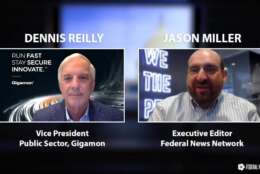SDFM The Business of Defense
-
Hosted by Dr. Richard Shurtz and Jim Russ. Sponsored by Stratford University. We get a recommendation for a good black and white laser printer that’s dependable, costs $200 or less, connects with Wi-Fi, will copy…
July 13, 2020 -
This content is provided by the IBM Center for the Business of Government. Mondays at 11:00 a.m. & Fridays at 1:00 p.m. The Business of Government Radio Hour, hosted by Michael J. Keegan, features a…
July 13, 2020 -
Agencies can take the lessons learned from the pandemic and continue to apply them to their broader mission areas.
July 10, 2020 -
FEDtalk On FedTalk this week, join host Natalia Castro for a conversation regarding how systemic racism and discrimination impact the federal workforce. Guests will be discussing challenges the federal government faces when addressing issues of…
July 10, 2020 -
Agencies have an opportunity now more than ever to take advantage of emerging cybersecurity tools on premise and in the cloud.
July 07, 2020 -
When it comes to gathering data, the National Oceanic and Atmospheric Administration is one of the most network-intensive agencies you’ll find.
July 07, 2020 -
What is the history of U.S. Presidential Transitions? Why it is transition so important? How does the Center for Presidential Transition at the Partnership for Public Service work to improve this process? Join host Michael Keegan as he explores these questions and more with Dave Marchick, Director of the Center for Presidential Transition at Partnership for Public Service.
July 06, 2020 -
Satellite provides an alternate method to access communication networks – without relying on the vulnerable terrestrial infrastructure.
July 06, 2020 -
Hosted by Dr. Richard Shurtz and Jim Russ. Sponsored by Stratford University. We learn about map driving. And we meet the co-founder of Texas Instruments.
July 06, 2020 -
Dana Laake and her special guest Dr. Patrick K. Porter will discuss breakthroughs in brain health with light, sound and vibration.
July 06, 2020 -
Dennis Reilly, the vice president of public sector at Gigamon, said agencies can use the pandemic emergency to continue to make progress.
July 02, 2020 -
The greater part of the automation journey involves mentoring employees so that they understand not only how to use automation, but when.
June 30, 2020 -
When peeling back the layers of how digital identity can enable broader, stronger, and more convenient online transactions, four specific principles can be distilled.
June 29, 2020 -
Bryan Ware, the assistant director for cybersecurity at CISA, said improving the Automated Indicator Sharing (AIS) program is one of several initiatives his office is leading to help agencies better deal with the ever-growing, ever-changing cyber risk.
June 29, 2020 -
Hosted by Dr. Richard Shurtz and Jim Russ. Sponsored by Stratford University. We learn about supercookies. And we meet an early female pioneer in computer science.
June 29, 2020













